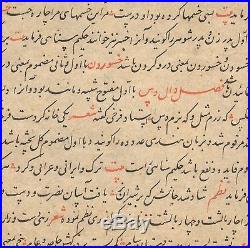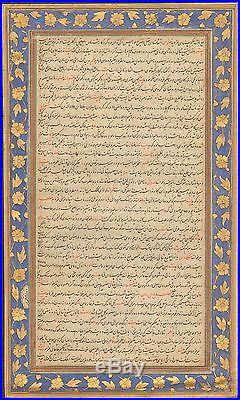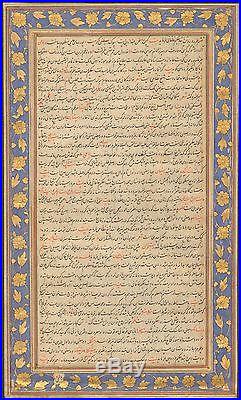Jahangir Dictionary Mughal Manuscript Persian Calligraphy Indian Painting 17th




You will find similar paintings listed in my other auctions. Folio from the Farhang-i Jahangiri (Persian-language Dictionary). Compiled by Mir Jamal al-Din Jusayn Inju of Shirazi Persian, d. Mughal, made for Emperor Jahangir, 1607-8 or 1622-23 Ink with gold on paper. 21.2 x 11 cm (text field). One of Jahangir's initial artistic acts as emperor was to complete the lavish embellishment of a Persian language dictionary that had first been commissioned by Akbar in 1595. It was completed in 1608 and named the Farhang-i Jahangiri in honor of the sitting emperor.
A second edition was presented to the emperor in 1623 on the occasion of Nau-ruz, the Persian New Year. In his memoirs, each chapter of which began with events of the annual Nau-ruz celebration, he wrote. On the nineteenth (March 30) the celebration of culmination was held, and many of my servants received promotions and suitable rewards. Mir Azud al Daula came from Agra to pay homage. He presented for my inspection the dictionary he had composed.
He really took a lot of trouble with it and persevered in citing examples for all the words from the poetry of the ancients. There is no other such book in this field. Pages from the Farhang-i Jahangiri are now widely dispersed and are found in several museums and private collections around the world. The borders of every known page, front and back, have extensive embellishment in gold, each with a different motif nestled amid glowing floral scrolls. The French art collector and dealer Georges Demotte admired the borders so much that he often mounted other paintings over the Persian words and definitions in the middle, so they would be surrounded by the decorative borders. Our folio is a rare remnant of the original text from the Farhang-i Jahangiri; it's borders no doubt now adorning some other great Mughal masterpiece. The author of the Farhang-i Jahangiri was Mir Jamal al-Din Husayn b. Fakhr al-Din Hasan Inju Shirazi Persian, d. 1626, known as Fakhr Husayn Inju, and his title was Azud al-Daula. He was born in Shiraz but lived in India from the time of his youth.Information obtained from Mughal Paintings Art and Stories, Quintanilla, 2016. Item is guaranteed to be authentic.
High resolution images are available upon request. Thank you for viewing my listing. The item "Jahangir Dictionary Mughal Manuscript Persian Calligraphy Indian Painting 17th" is in sale since Thursday, April 27, 2017. This item is in the category "Antiques\Asian Antiques\Middle East". The seller is "orientalminiatures" and is located in Honolulu, Hawaii.
This item can be shipped worldwide.